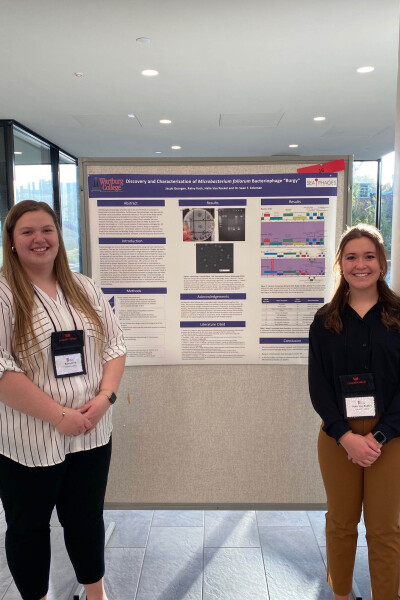Wartburg students’ research published in microbiology journal
October 26, 2022
Three Wartburg College students had their research on bacteriophages published in the American Society for Microbiology journal Microbiology Resource Announcements.
Senior Jacob Georgen and juniors Halle Van Roekel and Rainy Kock worked under the direction of Sean Coleman, associate professor of biology, to complete “Genome Sequence and Characteristics of the Microbacterium foliorum Cluster EE Bacteriophage Burgy.”
Bacteriophages, viruses that infect bacteria, are gaining popularity as a possible treatment for antibiotic-resistant bacterial infections, which are on the rise.
“There are believed to be more bacteriophages than there are grains of sand on the earth, and we know very little of their ecology,” Coleman said. “The bacteriophage highlighted in the article is a novel bacteriophage named ‘Burgy’ since it was the first identified at Wartburg College.”
Van Roekel and Kock also were able to present the research at the college’s Research, Internship, and Creative Endeavor Day in 2021 and again this month at the American Society for Microbiology North Central Branch meeting at Grinnell College.
“The most exciting part about this work was probably finding Burgy. I remember calling my family after hearing the news. Of course, they didn’t have a clue what I was talking about, but they were excited for me,” she said. “Another exciting part is just being able to share the work we’ve done. It’s pretty cool to see my name on published work. Presenting on Burgy has also been cool because we’ve been able to talk about Burgy with other students who either know about bacteriophages or don’t; and if they don’t, we get to teach them.”

Georgen and Kock helped Van Roekel purify and characterize the phage, which included getting pictures of the organism forming plaques and a transmission electron microscopic image of Burgy. With the help of the Howard Hughes Medical Institute’s SEA-PHAGES program, the team was able complete a genome sequence and annotation.
“So little is known about bacteriophage, so everything we learned was of some importance,” Georgen said. “Overall, this was a great learning experience, and I really enjoyed the whole process. Dr. Coleman is a great mentor and was there to help us at any point and time we needed it.”
Van Roekel is already planning the next steps in their Burgy research.
“We have to test its ability to disrupt a biofilm. A biofilm is just a high concentration of bacterial cells that stick together and often to a surface. They’re commonly found in nature or on the human body,” she said. “A common example seen in humans is plaque on the teeth. We’re going to see what concentration of Burgy is needed to disrupt biofilm. Is it a strong enough virus to disrupt biofilm at a small concentration or does it take a large concentration?”
Kock said the research, which was funded by a Wartburg Undergraduate Research Grant, challenged her to step outside her comfort zone.
“This will be a beneficial tool as I continue to encounter unknowns throughout my nursing education and career,” she said.
